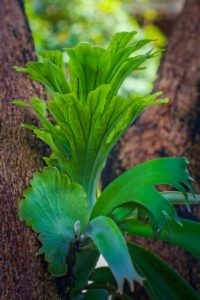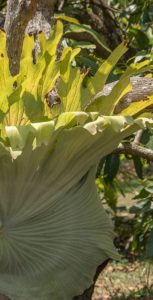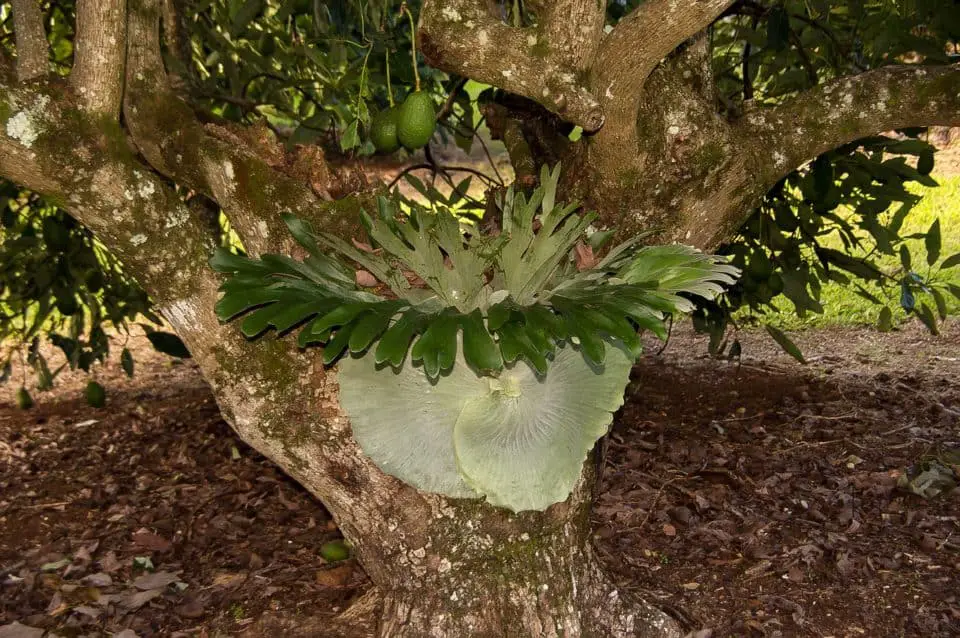Some links in the post are affiliate links and I get a commission from purchases made through some links found in the post.
Nowadays, instead of only relying on wall paintings and wallpaper to brighten a room, people have also taken to having plants in their home.
And with staghorn ferns, this plant placement has come with a twist. People are now mounting the ferns on their walls!
This strategic placement makes the house feel more earthy and works with any décor.
Thus, you can imagine how unsightly a browning or dying staghorn fern would be, perched on your wall but worry not we will help you save it.
This article will address any concerns you may have about your plant and get into how you can deal with any issues affecting your plant.
There are lots of signs in which you can tell your staghorn fern is dying, one of which is due to the fronds beginning to brown or blacken, the cause of this is overwatering.
A staghorn fern only need to be watered once a week during summer and once every 2 weeks during winter.
Once you have accessed what the problem is with your plant, the proper care practices will need to be taken to bring it back to health.
Why do People Hang Staghorn Ferns?
 When young, these ferns can do well in pots. However, you have to keep in mind that when bringing a plant indoors, you must simulate its native environment.
When young, these ferns can do well in pots. However, you have to keep in mind that when bringing a plant indoors, you must simulate its native environment.
In the wild, mature staghorn ferns grow on other plants. As such, you have to allow the plants to replicate the same indoors by mounting them.
So this makes your staghorn fern great to hang up in your home.
How do Staghorn Ferns Grow?
It’s imperative that you understand that this fern type is quite different from most other plants.
First, they are very picky and will easily react to adverse conditions. To grow a staghorn fern you must make sure that the environment is ideal and that you address any issues as soon as they arise.
Secondly, the leaves are not leaves as such, but rather, they are fronds.
The main frond is the antler frond, hence the name staghorn, which shoots out from the centre of the plant.
This frond develops spores on its lower side, and you should never remove these. Unlike other plants that reproduce by seeds and flowers, staghorn ferns rely on these spores.
Around the antler frond are the shield fronds, which are hard and surround the plant base.
They protect the roots and also take up water and nutrients to support plant growth.
The last part is the root ball. Interestingly, it serves the role of attachment to the host plant and is thus quite shallow, given that the plant relies on its antler fronds for nutrition.
As such, you should not overwater the plant as the roots do not need much water. If you water the staghorn fern as you would any other plant, root rot will likely occur.
But we will get into that later. For now, let’s focus on why your plant could be dying and what you can do about it.
How to Save a Dying Staghorn Fern?
As a new staghorn fern gardener, you may mistake natural plant changes as signs of death. When antler fronds come out at first, they are green.
However, as they continue serving the roles of taking up water and nutrients, they start aging and eventually turn brown.
At some point, they will completely dry up and guess what- it’s normal!
It does not indicate that the plant is dead, and you should never remove the dried fronds. Leave them in place and give the plant time to recover.
However, there are some cases where you might need to address some issues to save your dying staghorn fern, such as:
- Pale leaves
- Spots or patches on its leaves
- Browning on the edges of the fronds
- Poor development of fronds
- Signs of pest infestation
- Collapsing
If your plant exhibits any of the above warning signs, the staghorn fern could be dying as these are not natural phases of its life cycle so you may need to step in and save it.
Why is Your Staghorn Fern Collapsing?
Like we earlier covered, these plants do not rely on their roots for much other than supporting the plant.
However, if you are not aware that the antler fronds are the main working parts in maintaining the plant’s health, you can easily overdo the watering.
If you notice that your plant is slowly collapsing, you may want to cut back on the watering and try and save the plant from root rot.
The same also holds if you notice any brown or black spots on the base of the antler fronds.
If you’re enjoying this article, check out our article on what are the benefits of a boston fern.
How Can You Deal With Staghorn Fern Root Rot?
First, you need to get rid of the affected leaves using clean equipment to avoid the rot from spreading to other parts of the plant.
Secondly, you need to reduce how much you water the plant and give the plant a break to recover from the excess watering.
Once the plant starts showing signs of recovery, you can commence watering again, ensuring that you reduce the frequency to once a month and do not drown the roots and antler fronds again.
Also, if the plant is growing in soil, ensure that the soil dries before watering the plant again. Keep watching the plant to see if it improves, and keep adjusting the watering accordingly.
How Should you Water Your Fern?
 The staghorn fern requires both misting and watering for it to do well.
The staghorn fern requires both misting and watering for it to do well.
For the misting, you need to have a spray bottle that can direct water to the underside of both the antler and shield fronds, thus targeting the spores.
As for the soaking, you need to leave the fern in a bowl of water for about twenty minutes to a point where the roots are fully saturated.
You can also hold the fern in water for a few minutes and remove it when the roots are full.
Remove the plant from the water and allow it to drip the excess water before mounting it back to its spot.
Why is Your Staghorn Fern Turning Brown?
Browning on the antler fronds followed by complete drying of the leaves is common with ferns as it’s a natural part of their growth.
However, if the browning only shows on the edges of the fronds, your fern may need a better location.
Often, this owes to the fronds being in contact with dry air. It can easily show when the plant is near a heat source, a window, an air conditioner or any other spot that predisposes it to the harsh elements.
In some cases, the browning may indicate that the plant is not getting sufficient water.
Regulating the Temperature
While these ferns can withstand cold temperatures most of the time, the levels should never go below 50 degrees as this can cause damage to the fronds.
Also, the temperatures should not be above 100 degrees as this can scorch the fronds.
You want to maintain a temperature range between these extremes and avoid spots in the house that are too cold or hot.
Also, keep the ferns out of the direct sun to prevent any sun damage on the fronds.
For all you gardeners out there, an article you may find interesting is how to grow asparagus ferns from tubers.
How Often Should you Water Your Fern?
As much as overwatering is a big problem, you should also not underwater the plant and give it less water than it needs.
You need to water the plant at least once a week when you live in a hot area. If the temperatures are cool, you can get away with once every two to three weeks. But wait, not just yet.
The watering schedule depends on other factors as well. For example, if you live in a humid area, you will water the plant less because the fronds can take up water from the environment.
People growing their fans in a bathroom can cut back on watering by a great deal. Other factors include light and temperature. If these are high, you need to increase the watering.
Remember that you should look out for signs of overwatering- browning or blackening at the base. If this shows, reduce the watering to once a month until the plant recovers.
If you notice browning on the tips or wilting, increase the watering. It’s all about striking the perfect balance.
If you need help watering your staghorn fern, try using this automatic drip irrigation kit.
Why is Your Staghorn Fern Pest-Infested?
Usually, the staghorn fern does not serve as a host to pests.
However, where the plant does not have enough humidity or does not get the correct care it needs, it becomes unhealthy- and becomes an ideal host for pests.
In most cases, scales affect the plant, but mealybugs can also appear on the underside of the fronds.
How to Deal with Scale Insects
First, you need to get rid of the infested fronds by cutting them with a clean knife, ensuring you do not injure the plant.
If the scale insects are not many, you can rub them off or even pick them by hand. Follow through with soaking a cotton swab in alcohol and dab this on the plant.
You can also try introducing insects such as ladybugs to the plant to feed on the scale insects at their larval stages.
If the numbers are moderate, you can try organic insecticides to kill the larvae. Please note that these insecticides require frequent applications to be effective.
For large numbers of insects, you can go with botanical insecticides to get rid of the insects for good.
Other Common Problems
Why Does Your Staghorn Fern Have Patches or Spots on its Leaves?
You need to look into whether the plant has suffered shock from cold exposure or is overwatered.
Why Does Your Staghorn Fern Have Pale Leaves?
Your plant may require more shade as the sunlight may be scorching its fronds.
Why Ddoes Your Staghorn Fern Have Small Fronds?
The plant can either be getting low humidity or inadequate light. Try fixing one or both of these issues and see how it responds.
Final Thoughts: How To Save A Dying Staghorn Fern
 With a staghorn fern, you need to understand what’s part of its life cycle and what is not.
With a staghorn fern, you need to understand what’s part of its life cycle and what is not.
For the most part, your plant’s antler fronds will dry up from time to time, giving rise to more growth.
However, anything that veers from this norm, such as pest infestation, is not part of its life cycle, and you need to act fast before the plant actually dies.
Happy Gardening!
Before you go, here are some more related articles I encourage you to read below to help solve more of your gardening issues:
Can I grow ferns in water only.
How to Stop Your Boston Fern Leaves Curling
Why Does Your Fern Smell Like Fish and How to Fix it
How to Make Homemade Fertilizer For Ferns
What is the Ideal Humidity for a Boston Fern


